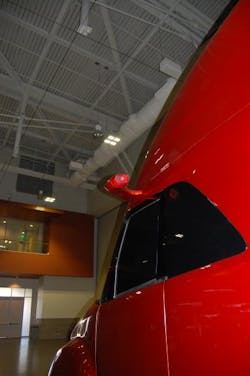Rear-view and side-view mirrors on new vehicles will begin to see major changes over the next decade, according to analysis from consulting company IHS Markit, as the combination of high-definition cameras and displays in place of – or in complement to – “traditional” mirror designs offers what the firm’s analysts describe as a “compelling case” for improving fuel efficiency.
According to IHS Markit’s Camera and Display Mirrors Report, the initial production applications of rear- and side-view camera displays in 2015 by General Motors for its Cadillac automobiles, with expansion to Chevrolet models and soon Buicks, offer drivers a “substantially wider field of vision” helping to eliminate blind spots from rear seat occupants or roof pillars.
With regulatory approval and early signs of customer acceptance, rearview display mirrors are expected to reach nearly 1.8 million units produced annually in 2025, led by markets in Japan and North America, according to IHS Markit global forecasts.In terms of cameras replacing side-view mirrors, the firm said aerodynamic improvements and enhanced visibility are the primary drivers. The market for dedicated side-view camera display mirrors will grow as a result, with initial production expected within the next 12 to 24 months, according to IHS Markit.
By 2025, more than 1.8 million vehicles will be produced with side-view camera sensors to support drivers or contribute to automated driving systems, with more than 23% or nearly 500,000 “completely shedding” the traditional side-view mirror, according to IHS Markit forecasts.
Implementation and cost, however, remain major barriers to widespread adoption of both rear- and side-view camera displays, noted Brian Rhodes, an automotive technology analyst with IHS Markit.
“Suppliers and automakers are investigating several different ways to replicate the camera view with an in-vehicle display. These side-view images could feed through an instrument cluster display of some sort, or even a traditional center stack display,” he said.
“However, the majority of concepts to this point have focused on new, dedicated side-view displays located either in the door panels or A-pillars because they offer the driver the most familiar line of sight for this safety-critical aspect of driving,” Rhodes noted.
“Current side camera systems merely enhance the driver’s view today and provide marginal added safety as a result, but there is much more opportunity,” said Jeremy Carlson, principal automotive analyst with IHS Markit. “Camera sensors allow machine vision software and artificial intelligence to constantly detect, track, and recognize objects over a wide field of view, and that can be important input to autonomous driving solutions.”
Alongside the “autonomous use case,” which has varying levels of interest from different automakers, Carlson stressed that improving aerodynamics will improve fuel efficiency no matter the fuel used—and that should be of interest to every automaker given regulatory pressures on fuel economy and greenhouse gas (GHG) emissions across the world today.

